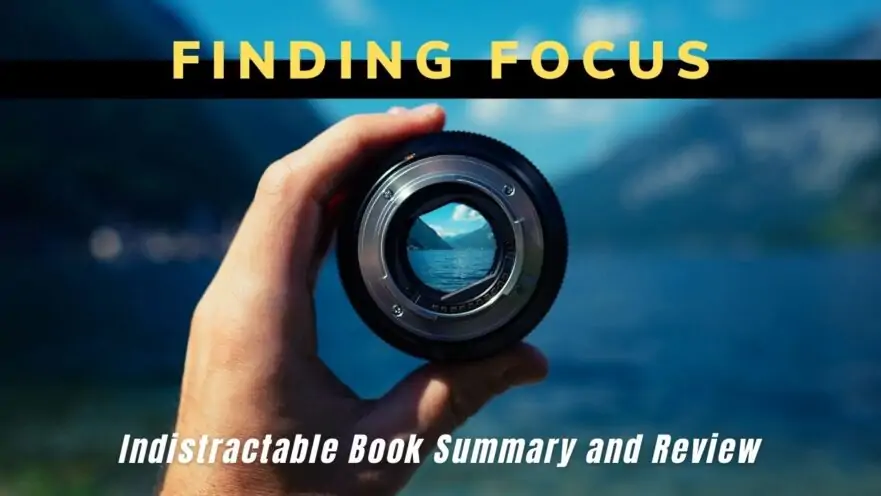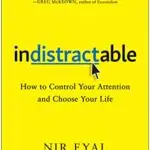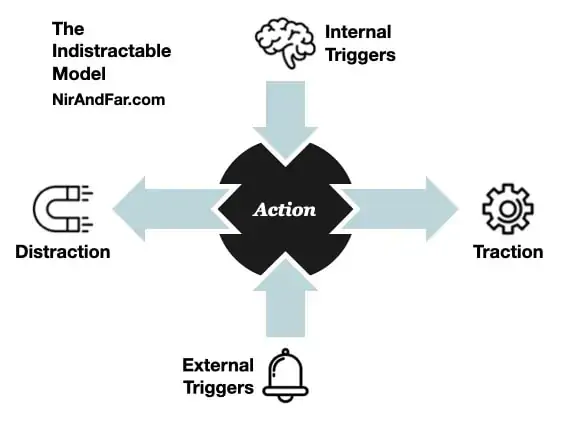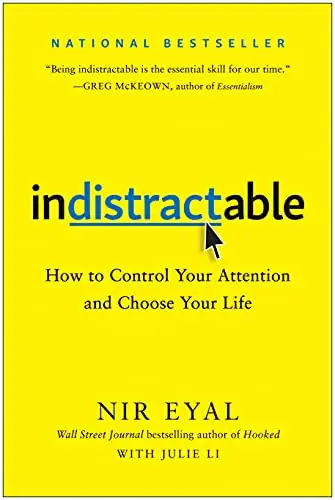One of the biggest obstacles standing in the way of creating the life or lifestyle that we really desire is often simple but recurring distractions that pull us away, delay us, or prevent us from doing the things we really should be doing. It seems like distraction is all the more prevalent today thanks to our electronic devices that have trained us so well. I too frequently struggle with the magnetic pull of distraction, which is why I picked up the book Indistractable by Nir Eyal. Let’s review some of the key takeaways of the book with this Indistractable summary and book review.
Indistractable: How to Control Your Attention and Choose Your Life is a book that aims to explain what exactly distraction is, what triggers it, and how we can attempt to corral it so we can work toward the things that really matter to us in life, whether they are professional, personal, interpersonal, or even just having fun.
This is part of my series of book summaries for online entrepreneurs and digital nomads.
Indistractable Summary
While I love the life of location independence and running my small business, I do have to admit that it is infinitely more easy for me to get distracted and fall and into a rabbit hole of things that don’t do anything to advance my goals, thanks to the fact that I don’t have coworkers to hold me accountable or a boss breathing down my neck. Over the past few years, I find myself oscillating between periods of great progress and other periods of being adrift, so to speak.
It is these periods of being adrift where I am most prone to distraction. In Nir Eyal‘s book, he defines being distraction as being anything that pulls us away from what we want to be doing in the moment. Distraction is the exact opposite of traction, or that which is pulling us toward or objectives.
To be clear, these objectives or this traction doesn’t have to be some major, transcendental life goal. It applies just as much to situations where you set down to work and get distracted by YouTube recommendations as when you sit down to watch Netflix with a loved one and get distracted by the phone vibrating next to you.
Either way, some internal or external factor is pulling your attention and focus away from what you set out to do. Indistractable tries to help us better understand these internal and external factors vying for our attention.
Internal Triggers
The first section of the book speaks to the internal distractions that come from within us. These can be simple things like feeling hunger or other physiological triggers, but more often we are dealing with some sort of uncomfortable internal trigger that can lead us to escapism. It is this discomfort that can cause us to seek out a distraction. While we often think of cell phone addiction as one of the greatest distractions, the fact is that distraction can take many forms as it has in previous decades, whether television, cigarettes, junk food, video games, etc. If we want to master distraction, we must learn to deal with discomfort and master internal triggers.
In order to deal with the internal triggers, we must be mindful about what causes them and the sensations that go along with it. The primary advice here is not to suppress those urges, but to notice them and watch them pass. The book is backed up with all sorts of interesting studies, particularly those in the field of addiction, that can help us better control these impulses that might otherwise led us to distraction in order to avoid discomfort.
One study of smoking flight attendants on Transatlantic flights found that the smoking craving was not related to how much time had passed since their last cigarette, but rather how much time was left until they could smoke their next one. Cravings were highest as landing approached, regardless of time in the air or how many hours since they last smoked.
Making Time
Part II of the book primarily deals with the importance of planning your time, using time blocking and scheduling so you can better focus on the things that align with your values and goals. Again, this doesn’t need to be a Type-A go-go-go schedule that is all work and no play.
Indeed, it is important to schedule downtime, playtime, or whatever you want to call it. If you’re planning to spend the evening in a Netflix and chill mode, then that is time well spent, and isn’t a distraction from the things you had otherwise planned to do. If you schedule time for the things that matter most to you, then you will be better able to prioritize them and realize when other things are distracting you from that.
External Triggers
Part III of the book deals with a myriad of external triggers which are the things we typically associate with distractions in a variety of settings, including at the office. External distractions or those things that just pop up and pull you away from what you were doing (including coworkers showing up at your desk).
Hacking back your smartphone is certainly one chapter that everyone today should read and something that I have largely been doing for a few years now. It mainly consists of limiting basically all the push notifications from your cellphone, rearranging things, and utilizing functions like Do Not Disturb. I used to hate the constant vibrations while I was writing and which would inevitably distract me and almost force me to look to see if it was something important. It almost never was.
Read More: Hack Back Your Smartphone
Personally, I’ve turned off push notifications and badges for virtually everything on my phone except WhatsApp (where family and close friends contact me) and phone calls. Things like email or other former constant interruptions require me to actually open the app and check it. Other apps that hold the potential to be true time sucks like Facebook with its endless newsfeed, have been completely removed from my phone. I don’t miss it. Things like that can be used on my laptop, although I don’t use it much there either.
There are tons of other tips that apply to today’s tech heavy age, like how to reduce email distractions (with the unconventional advice to just send fewer emails). One of the new tips that I immediately implemented upon reading the book was installing DF Tube browser extension so I could enjoy a Distraction-Free Youtube. I use YouTube a lot for either ambient music playlists while I work or for different learning materials (I’ve been devouring a lot of investment material lately).
This awesome browser extension completely removes the suggested videos sidebar and the (troll-filled) comments section below. Now I don’t find myself getting distracted from the video I wanted to watch or learn from by checking out the suggestions for what I might want to watch next, or reading the inane comments below — both of which I would inevitably do on virtually every video.
Pacts Prevent Distraction
Finally, Part IV deals with the use of pacts in order to really cement your behavior, provide accountability, and become Indistractable. The idea of using pacts is something I’ve already implemented at times, but it was a good refresher. The three main pacts are Effort Pacts, Price Pacts, and Identity Pacts.
An Effort Pact is just making something distracting or undesirable a little more inconvenient to you. This could be something like uninstalling Facebook from your cellphone so you can only use it on a computer. Or it could be something like keeping junk food hidden away and out of sight. You are just imposing some sort of barrier between you so it isn’t a mindless effort to scroll through Facebook or social media. You give yourself time to stop to unwanted behaviors.
The Price Pact is basically putting your money where your mouth is when it comes to action. The main example in the book of doing taping a $100 bill to a calendar with the idea that he had to exercise a little every single day or burn the $100 bill was kind of dumb. Even if I tried and failed, I don’t think I’d have the willpower to burn money.
Outside the book, I’ve heard of better examples where you can set automatic accountability with, say, donations to a group you are ideologically opposed to in the event you don’t follow through. So you could have it donate to the opposing political party like the Democrats or Republicans or a polarizing non-profit group like the NRA or Planned Parenthood.
The Identity Pact is fairly simple, but it has to do with fostering and cultivating the identity you desire and recognizing yourself as such with time. For example, if someone is a Vegetarian, the very idea that they don’t eat meat is pretty core to their identity, therefore whether they should eat the hamburger isn’t likely to be a struggle. It is harder to go against your identity. This is where the book gets the name Indistractable, by the way, if you can identify yourself as such, then you will be less prone to distraction, as opposed to people who tell themselves (and others) “I’m easily distracted.”
The first four parts of the book are the core, but there are subsequent sections on raising indistractable kids, creating an indistractable workplace, and building indistractable relationships (friendships and romantic).
Confronting My Distractions
I’d already tackled my distractions with cellphone overuse by limiting those external triggers and is something I highly recommend. But I’d never really found myself focusing on or even recognizing the internal triggers that distract which is something that this book has helped me pay attention to ways I can prevent distractions.
In terms of my work and business, I have been neglecting it a lot lately, ever since the pandemic started basically, and cut my business revenue in half. In that time, I’ve been more distraction prone than ever and I am trying to force myself to get back on track, to align my actions with my goals and values, and continue working towards them.
While the pandemic opened up new avenues and explorations, it was time for me to renew my focus and start mapping out a new direction. In that way, the Indistractable book has helped me find more clarity and I hope its lessons will continue to guide me going forward. But if I do get distracted, I feel like this is a book I could return to read again.
Indistractable is an important read for the modern generation who are faced with a world of distraction right in their pockets and at their finger tips. This book is a light, easy, and relatively quick read, backed with the basic theory, numerous scientific studies, and a plethora of actionable recommendations to reduce distractions in your life. I’d highly recommend picking up a copy today.
Share This
I hope you enjoyed this book summary of Indistractable by Nir Eyal. I’d highly recommend checking out the book and finding new ways of making unwanted behaviors a little more difficult.
Ryan
Latest posts by Ryan (see all)
- Kazakhstan Food: Exploring Some of its Most Delicious Dishes - August 7, 2023
- A Self-Guided Tour of Kennedy Space Center: 1-Day Itinerary - August 2, 2022
- Fairfield by Marriott Medellin Sabaneta: Affordable and Upscale - July 25, 2022
- One of the Coolest Places to Stay in Clarksdale MS: Travelers Hotel - June 14, 2022
- Space 220 Restaurant: Out-of-This-World Dining at Disney’s EPCOT - May 31, 2022




